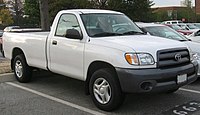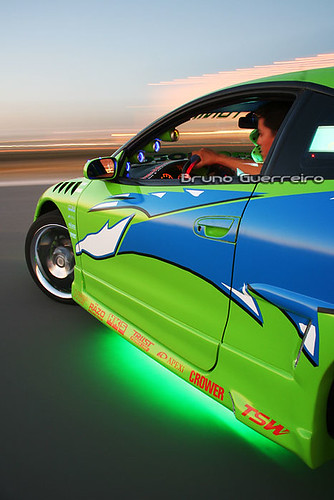The Toyota Tundra is a full-size pickup truck sold by Toyota that originally went into production in 1999 (as a 2000 model year model), replacing the Toyota T100. The Tundra had a more American look and feel and ultimately had something the T100 never had, a V8 engine underneath its hood. The Tundra was nominated for the North American Truck of the Year award and was Motor Trend magazine's Truck of the Year in 2000 and 2008. As of 2007, the Tundra (now in its second generation) holds 17% of the 1/2 ton full-size pickup market beating the GMC Sierra in monthly sales, but still behind the Dodge Ram, and the best-selling Ford F-150 (in overall sales). The newest Tundra is assembled in San Antonio, Texas, and Princeton, Indiana (where the original Tundra was solely constructed).
The first generation Tundra had many similarities with the old Toyota T100 and the smaller, more popular Toyota Tacoma. The biggest of those similarities was the use of the 3.4 liter V6 engine which was the top of the line engine in both the Tacoma and T100, while it became the base engine within the Tundra. The then new Tundra had an optional 32 valve 4.7 liter V8 powerplant which ultimately became the most desired engine of choice. The first generation Tundra also became the model upon which the original Toyota Sequoia full-sized SUV was based. The two vehicles shared a host of parts and accessories including the 4.7 liter V8 engine, wheels, tires, transmissions and interior components among them.

Publicly introduced in May 1999 as a 2000 model, the Tundra prototypes and "show trucks" were initially known as T150s. However, Ford and automotive pundits felt that this name was too close to the market-leader Ford F-150, and following a lawsuit by Ford, the production truck was renamed the Tundra (Toyota claimed they never truly intended to use the T150 name in actual production). Toyota then countersued Ford regarding the name of their then-released Lincoln LS sedan, arguing it was too close to that of the Lexus LS.

The Tundra was slightly larger than the T100, but still suffered the perception of being too small and carlike to pose a serious threat to the domestic pickup trucks. With a production capacity of 120,000, sales were double the rate of the T100. The Tundra also had the largest initial vehicle sales for Toyota in its history (up until that time). It garnered impressive honors, including Motor Trend's Truck of the Year award for 2000 and Best Full- Size Truck from Consumer Reports. Built in a new Toyota plant in Princeton, Indiana, with 65 percent domestic content, the Tundra showed that Toyota was serious about closing the gap on the Big Three.
Engine choices available in the Tundra were a 24V 3.4 liter V6 engine that produced 190 horsepower (140 kW) and 220 ft·lbf (298 N·m) of torque and a 32 valve 4.7 liter V8 engine that produced 245 horsepower (183 kW) and 315 ft·lbf (427 N·m) of torque. A Toyota Racing Development (TRD) derived supercharger was already available for the 3.4 liter V6 that bumped horsepower to the 260 horsepower (190 kW) range and 260 ft·lbf (353 N·m) of torque range, but TRD introduced a supercharger for the V8 engine late into its second year of production that pushed the V8 numbers to the mid 300 horsepower (220 kW) range and torque to the 400 ft·lbf (550 N·m) range. Although the V6 supercharger is still widely available, the V8 supercharger is rarer and harder to find because of TRD stopping production of the device because of issues of its compatibility with the engine.


0 comments:
Post a Comment